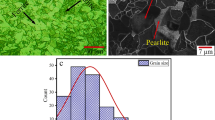Abstract
Flux Bounded TIG welding is a variation of Activated TIG welding wherein a narrow strip of base metal is coated with activating flux and is exposed to the arc during welding. Bead on plate welds by FBTIG process on commercially pure aluminium plates were performed using silica as flux. This paper investigated the effect of flux gap and flux powder particle size on the weld penetration and depth to width ratio. Microstructural analysis was carried out to understand the changes in grain structure in the weld pool and adjacent zones. It was observed that the weld penetration and depth to width ratio increased with the decreasing flux gap. Also, results showed better penetration for activating flux with finer flux powder size. The mechanisms that supported these observations have been explained.









Similar content being viewed by others
References
Brungraber R J, and Nelson F G, Weld Res (Suppl Weld J) (1973) 97.
Simonik A G, Weld Prod 3 (1976) 49.
Ruckert G, Perry N, Sire S, Marya S, Enhanced Weld Penetrations In GTA Welding with Activating Fluxes Case studies: Plain Carbon & Stainless Steels, Titanium and Aluminum. THERMEC, p 202.
Sire S, and Marya S, Int J Form Process 5 (2002) 39.
Modenesi P J, Apolinario E R, and Pereira I M, J Mater Process Technol 99 (2000) 260.
Leconte S, Paillard P, and Saindrenan J, Sci Technol Weld Join 11 (2006) 43.
Mitchell B S, An Introduction to Materials Engineering and Science for Chemical and Material Engineers, Wiley-Blackwell, New Jersey (2004).
Patel A B, and Patel S P, Int J Eng Res Appl 4 (2014) 41.
Zhao Y, Yang G, Yan K, and Liu W, Adv Mater Res 311–313 (2011) 2385.
Fan D, Zhang R, Gu Y, and Ushio M, Trans JWRI 30 (2001) 35.
Howse D S, and Lucas W, Sci Technol Weld Join 5 (2000) 189.
Fujii H, Sato T, Lu S, and Nogi K, Mater Sci Eng A 495 (2008) 296.
Xu Y L, Dong Z B, Wei Y H, and Yang C L, Theor Appl Fract Mech 48 (2007) 178.
Lu S, Fujii H, and Nogi K, Mater Sci Eng A 380 (2004) 290.
Sattler K D, Handbook of Nanophyics, Nanoparticles and Quantum Dots, CRC Press, Taylor & Francis Group, Boca Raton (2011).
Lai S L, Guo J Y, Petrova V, Ramanath G, and Allen L H, Phys Rev Lett 77 (1996) 99.
Lu S, Fujii H, Sugiyama H, Tanaka M, and Nogi K, Mater Trans 43 (2002) 2926.
Ruckert G, Huneau B, and Marya S, Mater Des 28 (2007) 2387.
Santhana Babu A V, Giridharan P K, Ramesh Narayanan P, Narayana Murty S V S, and Sharma V M J, J Adv Manuf Syst 13 (2014) 103.
Acknowledgments
The authors acknowledge Shri. Santhana Babu, Scientist, SHAR, ISRO for providing the necessary materials for the experiment and Shri. Thomas Varghese for providing assistance for carrying out the experiments.
Author information
Authors and Affiliations
Corresponding author
Rights and permissions
About this article
Cite this article
Jayakrishnan, S., Chakravarthy, P. & Muhammed Rijas, A. Effect of Flux Gap and Particle Size on the Depth of Penetration in FBTIG Welding of Aluminium. Trans Indian Inst Met 70, 1329–1335 (2017). https://doi.org/10.1007/s12666-016-0929-1
Received:
Accepted:
Published:
Issue Date:
DOI: https://doi.org/10.1007/s12666-016-0929-1




